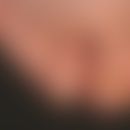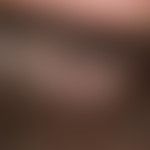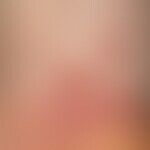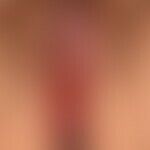Synonym(s)
HistoryThis section has been translated automatically.
Ferdinand v. Hebra 1860; Ernest Pierre Antoine Bazin 1862; Erasmus Wilson described the disease as lichen planus in 1869. He distinguished between several forms: lichen planus discretus, lichen planus aggregatus, lichen planus anulatus, lichen planus marginatus and lichen planus mucosae. Weyl later mentioned Wickham's spots and streaks on the surface. He also pointed out linear formations after mechanical insults, a phenomenon that was later described by Köbner and is still not fully understood today. Cases of this type were also referred to as lichen striatus. For a long time there were also discussions about the distinction between lichen planus and the lichen atrophique described by Francois Henri Hallopeau, later also described as lichen sclereux and today clearly and independently defined as lichen sclerosus. Alfred Blaschko and Josef Jadassohn discussed the similarity between lichen planus and the melanosis of war, which was common at the time. The possibility of blistering in lichen planus(lichen planus pemphigoides) has already been pointed out by the Viennese dermatologist Moriz Kaposi.
See also the newsletter"Lichen ruber".
DefinitionThis section has been translated automatically.
Non-contagious, acute, subacute to chronic, usually markedly itchy, self-limited (disease duration between 1 month and 10 years), (autoimmunologic) inflammatory (non-systemic) disease of the skin and/or (squamous) mucous membranes of unknown etiology, with typical clinical (like polished shiny papules) and histological morphology (destruction of basal keratinocytes by cytotoxic T-cells, lichenoid inflammation) and a characteristic, often flexurally accentuated distribution pattern.
Lichen ruber (planus) is characterized by a characteristic "lichenoid tissue reaction", which can also characterize the histological picture in other inflammatory processes of the skin, e.g. in lichenoid drug reactions, in a"graft-versus-host reaction" in initial lichen sclerosus, in lupus erythematosus, in erythema dyschromicum perstans or also in actinic keratoses and is therefore characteristic but not specific for lichen ruber.
You might also be interested in
ClassificationThis section has been translated automatically.
Depending on the clinical morphology and distribution pattern, lichen planus can be classified as follows:
Classification according to distribution pattern:
- Lichen planus exanthematicus (generalized lichen planus)
- Localized lichen planus
- Erythrodermic lichen planus
-
Lichen planus linearis (Lichen ruber striatus)
- Blaschkoid lichen planus(cutaneous mosaic)
- Zosteriform lichen planus(isotopic response?)
- Inverse lichen planus (see below lichen planus pigmentosus inversus)
- Oral lichen planus (syn.Lichen planus mucosae)/lichen planus esophagitis (Blonski W et al. 2023)
- Lichen ruber genitalis (see also Lichen planus vulvae)
- Lichen planus palmoplantaris
- Lichen planus of the nails (nail lichen)
___________________________________________________________
Classification according to clinical appearance:
- Lichen planus classic type
- Lichen planus actinicus
- Lichen planus anularis
- Lichen planus verrucosus (hypertrophicus/obtusus)
- Lichen planus follicularis
- Graham-Little syndrome
- Lichen planus atrophicans
- Lichen plan userosivus (erosive lichen planus)
- Lichen planus pigmentosus
- Lichen planus bullosus
- Lichen planus pemphigoides (is regarded as a coincidental disease entity/overlap of lichen planus and bullous pemphigoid/comment: there are justified doubts about this thesis).
- Lichen planus erythemato-squamosus (lichen planus érythémato-squameux)
- Invisible lichen planus (Lichen invisible-Gougerot 1925) pruritic without clear clinical signs of LP; formerly lichen discretus). Remark: Entity is disputed.
- Overlap syndrome:
- Lichen planus bullosus/pemphigoides
- Lichen planus erythematosus/systemic lupus erythematosus.
Occurrence/EpidemiologyThis section has been translated automatically.
Prevalence: 0.6%-1.2% of the (adult) population and an incidence of 20.1/100,000 people. The incidence is highest in larger collectives between the ages of 60 and 79. In contrast, the incidence and prevalence in children and adolescents (<18) is low. The annual prevalence in pediatric collectives is 3.9/100,000 (Schruf E et al. 2021).
Up to 25% of patients have an isolated lichen planus of the mucosa (see below lichen planus mucosae).
Familial lichen planus is rare. About 100 cases have been documented.
EtiopathogenesisThis section has been translated automatically.
Autoimmune reaction: To date, the etiology and pathogenesis of lichen ruber is not fully understood. There are associations with autoimmune diseases, viral infections, medications (see Lichen ruber e medicatione) and mechanical trigger factors (scratching, rubbing, etc.). Lichen ruber-like lesions occur in chronic graft-versus-host disease (GVHD ), in which alloreactive, cytotoxic T cells and antibodies that recognize foreign MHC molecules are decisive effectors. Familial lichen ruber is known (rare). Lichen ruber also occurs as a mosaic dermatosis(lichen striatus), which could be explained by a somatic mutation.
The morphological pathogenesis is also not fully understood (Vogt T (2018). The morphological analogy of the lichenoid dermatitic reactions led to the hypothesis that lichen ruber is caused by an autoimmune reaction against epitopes of basal keratinocytes, which was modified or induced by viral or drug induction. The marked proliferation of antigen-presenting cells (APCs) is striking, mainly Langerhans cells, which are detectable in early lesions of lichen ruber. The APCs may be attracted by the keratinocytes themselves, possibly via defective cytokine production. Ultimately, the nature of the autoantigens remains unclear. The antigen-presenting cells activate autoreactive T cells, which produce further proinflammatory cytokines. The Th1 cytokine interferon-gamma appears to play a key role here.
It is undisputed that the apoptotic destruction of the basal keratinocytes represents the common final stage of the lichen ruber reaction. Ligand-receptor-dependent dysregulation (TNF-alpha/TNFR1 = TNF-alpha receptor) is discussed as the cause. Keratinocytes eventually perish due to an interaction of FasL, the activating ligand of the Fas receptor, and Fas. Furthermore, membrane-damaging perforins are expressed which cause direct "pore formation" in the cell membrane with subsequent release of enzymatically active serine proteases (see granzyme B below) from the T cells. This cytotoxic activity explains vacuolization, pigment incontinence (loss of melanin to the dermis), apoptotic camino bodies as morphological phenomena of the lichenoid reaction.
The role of melanocytes in the lichenoid tissue reaction is still unclear. The phenomenon of pigment incontinence is constantly detectable and indicates a disturbance of melanin transport.
It is undisputed that the apoptotic destruction of the basal keratinocytes represents the common final stage of the lichen ruber reaction (this certainly also plays an important role in other autoimmune diseases of the skin, e.g. LE). Ligand-receptor-dependent dysregulation ( TNF-alpha/TNFR1= TNF-alpha receptor) is discussed as the cause.
The direct "pore formation" by perforin and the subsequent enzymatic degradation by serine proteases (see granzyme B below), which is known to occur during apoptosis, is also discussed.
Further etiopathogenetic associations:
- Viral antigens appear to play a preferential role in the etiopathogenesis of lichen ruber. The prevalence of HCV/HBV infections(hepatitis C/B) is 13.5 times higher in lichen ruber than in controls. In oral lichen ruber, a high percentage of HCV RNA and TTV DNA (transfusion-transmitted virus) was detected in lesional mucosa. The occurrence of lichen ruber after HBV vaccination has been described. The etiopathogenetic association with HHV-7/HHV-8 cannot be clearly proven.
Vaccination and lichen planus: The occurrence of lichen planus after c has been described. It is postulated that virally altered hepatocyte antigens express epitopes with homologies to keratinocyte antigens and thus activate autoreactive cytotoxic T cells. The occurrence of lichen planus after SARS-CoV-2 vaccination has been described several times (Zengarini C et al. 2022). In contrast to this, the etiopathogenetic significance of lichen planus to HHV-7/HHV-8 cannot be clearly proven.
-
Drugs: Beta-receptor blockers, interferons, chloroquine and non-steroidal anti-inflammatory drugs are possible drug triggers.
Paraneoplasia: There are isolated reports of paraneoplastic lichen ruber. An association with thymoma has been described (see Good syndrome below)
-
Comorbidities
- Diabetes mellitus: An association of lichen ruber and diabetes mellitus is strikingly frequent. In every 2nd patient there is a disorder of glucose metabolism and in every 4th a manifest diabetes mellitus.
- Contact allergies: The role of contact allergies to a number of metal salts (gold, amalgam, copper) is well known in oral lichen planus. It is discussed that these antigens can trigger an LP reaction in the manner of haptens.
ManifestationThis section has been translated automatically.
Preferably occurring in adults between the 3rd and 6th decade of life, rarely in children (about 1-4% of cases). No ethnic predisposition. Women seem to contract the disease slightly more frequently than men (Schilling et al. 2018).
LocalizationThis section has been translated automatically.
Lichen ruber is preferentially found on mucous membranes covered with squamous epithelium (oral mucosa, vaginal or penile mucous membranes, oesophageal mucosa 65%), often on skin and mucous membranes at the same time (20%), less frequently isolated on the skin (10%). Involvement of the nails and hair can lead to permanent nail dystrophy or scarring irreversible alopecia.
The following nail changes are described in detail (cited in H. Hamm et al. 2018):
- Thinned nail plate
- Longitudinal furrows
- Onychorrhexis
- Dimples
- More rarely:
- Onychoschisis
- Trachyonychia
- Partial onchyoatrophy
- Coilonychia
- Onycholysis
- Onychomadesis
- Reddening of the lunulae
- Longitudinal melanonychia
- Complete atrophy and scarring of the nail organ with:
HistologyThis section has been translated automatically.
The histological picture of (classic) lichen planus (lichen ruber planus) is almost pathognomic and corresponds to the typical case of a mixed, epidermodermal papule. The uniform pattern of a classic interface dermatitis with irregular, often sawtooth-like acanthosis, compact orthohyperkeratosis with prominent hypergranulosis (circumscribed thickening of the keratohyalin-containing cell layers of the stratum granulosum causes the clinical picture of Wickham's pattern) can already be recognized on overview magnification. A prominent, dense, band-shaped, lymphoid cellular, epidermotropic infiltrate is usually conspicuous. The inflammatory infiltrate consists predominantly of oligoclonal, CD8-positive, cytotoxic T cells. Focal pigment incontinence is characteristic. The vacuolated degeneration of the basal epithelial cell layers can cause clefts (Max Joseph's spaces) and even subepithelial blistering (lichen planus bullosus). Detection of numerous cytoid bodies (Civatte bodies or cytoid bodies (colloid bodies) see below. apoptosis). Epidermal Langerhans cells are increased in active lesions.
A central biopsy from an ulcerated area often shows an inflammatory reaction with plasma cells and lymphocytes and the absence of typical features. Melanin incontinence with melanophages is usually variable, but is only evident in hyperpigmented clinical variants. Eosinophils may occur in drug-induced lesions.
In follicular variants, the lichenoid reaction affects the basal layer of the follicular epithelium; varying degrees of perifollicular fibrosis may occur.
Direct ImmunofluorescenceThis section has been translated automatically.
In lesional skin, cytoid bodies are found along the dermoepidermal junction in lichen planus, which may be aggregated individually or in groups. Granular deposits of fibrin, IgM and C3 are also found. IgA and IgG deposits can sometimes be found in the same localization. The cytoid corpuscles correspond to apoptotic material of basal keratinocytes. However, these are not pathognomic for lichen planus but are also found in other lichenoid diseases.
Differential diagnosisThis section has been translated automatically.
In the differential diagnosis of lichen planus, depending on the type of lichen planus and the localization of numerous diseases must be considered:
- Lichen nitidus: exanthematic, not itchy, small papular, gray-brownish
- Lichen sclerosus: whitish genital plaques
- Lichen spinulosus: acquired, usually blurred, non-itching, 5.0-6.0 cm large, slightly scaly, dry areas characterized by multiple, disseminated, 0.1-0.2 cm large, skin-coloured, follicular papules
- Acute graft-versus-host disease: medical history, lichenoid exanthema
- Lichen striatus (with striated arrangement): indistinguishable from LP
- ILVEN (linear epidermal nevus): indistinguishable from LP
- Nummular dermatitis: initially small, reddish-brownish, itchy, red scaly or crusty papules, papulo-vesicles or plaques. Gradual growth in size to sharply or blurredly defined red coin-like ("nummular eczema") plaques. Clinical picture is diagnostic.
- Lichen simplex chronicus: Ledit symptom is itching, nummular plaques typically with a three-zone structure, histology is diagnostic
- Chronic prurigo: exanthematous disseminated scratched, very itchy nodules and lumps
- Pityriasis rosea (exanthematic with eczematoid scaling, primary medallion)
- Psoriasis guttata (exanthematic with characteristic scaling, often accompanied by infection)
- Eczematid-like purpura (predominantly lower extremity, always punctiform hemorrhages)
- Lichenoid drug exanthema (indistinguishable from exanthematic LP)
- Early syphilis (anamnesis, possibly primary effect still detectable, exanthematic, lymphadenopathy)
- Gianotti-Crosti syndrome (papular acrodermatitis in childhood) (history of infection, lymphadenopathy, acral localization, also blistering, no itching)
- Granuloma anulare (no itching, conspicuous chronicity, no red but brown tone)
- Lichen amyloidosus (very hard, almost rubbing iron-like, skin-colored to brown, mostly grouped, warty-rough or lichenoid shiny papules, often scratched)
- Pityriasis lichenoides (colorful picture, as in the "Heubner's star map"; only moderately itchy, possibly burning, but often (in 50% of patients) also completely asymptomatic exanthema.
DD in certain locations:
Nails: psoriasis, onychomycosis, alopecia areata, atopic dermatitis
genital area lichen sclerosus, mucous membrane pemphigoid, vulvar intraepithelial neoplasia, graft-versus-host reaction, psoriasis, seborrhoeic dermatitis, intertrigo
palms and soles: Secondary syphilis, psoriasis vulgaris, warts, calluses, porokeratosis, hyperkeratotic eczema, pityriasis rubra pilaris, tinea, drug reaction
Capillitium: Lichen planopilaris, cicatricial alopecia, lupus erythematosus, inflammatory folliculitis, alopecia areata, mucous membrane pemphigoid, frontal fibrosing alopecia
Mucosa: Paraneoplastic pemphigus, candidiasis, lupus erythematosus, secondary syphilis (mucoid plaques), leukokeratosis, traumatic spots, cicatricial pemphigoid
Progression/forecastThis section has been translated automatically.
Classic cutaneous lichen planus is self-limiting and usually heals within 6 (>50%) to 18 months (85%). A chronic course is more likely to occur with hypertrophic cutaneous lesions, orogenital lichen planus and involvement of the nails or scalp. Hyperpigmentation is most common in people with darker skin. They can have a considerable cosmetic impact.
LiteratureThis section has been translated automatically.
- Awada B et al. (2022) Inverse lichen planus post Oxford-AstraZeneca COVID-19 vaccine. J Cosmet Dermatol 21:883-885.
Blonski W et al (2023) Lichen planus esophagitis. Curr Opin Gastroenterol 39:308-314.
- Brănişteanu DE et al. (2014) Cutaneous manifestations associated with thyroid disease. Rev Med Chir Soc Med Nat Iasi 118: 953-958
- Butch F et al (2014) Successful treatment of lichen planus of the nails with ciclosporin. JDDG 12: 724-725
- Chiheb S et al. (2015) Clinical characteristics of naillichen planus and follow-up: A descriptive study of 20 patients. Ann DermatolVenereol 142:21-25
- Deen K et al. (2015) Mycophenolate mofetil in erosive genital lichen planus: A case and review of the literature. J Dermatol doi: 10.1111/1346-8138.12763
- De Vries et al. (2007) Lichen planus remission is associated with decrease of human herpes virus type 7 protein expression in plasmacytoid dendritic cells. Arch Dermatol Res 299: 213-219
- Eisman S, Orteu CH (2004) Recalcitrant erosive flexural lichen planus: successful treatment with a combination of thalidomide and 0.1% tacrolimus ointment. Clin Exp Dermatol 29: 268-270
- Frieling U et al. (2003) Treatment of severe lichen planus with mycophenolate mofetil. J Am Acad Dermatol 49: 1063-1066
- Gandolfo S et al. (2004) Risk of oral squamous cell carcinoma in 402 patients with oral lichen planus: a follow-up study in an Italian population. Oral Oncol 40: 77-83
- Hamm H et al. (2018) Diseases of the nails. In: Braun-Falco`s Dermatology, Venereology Allergology G. Plewig et al. (Eds.) Springer Verlag S 1400
- Harden D et al. (2003) Lichen planus associated with hepatitis C virus: no viral transcripts are found in the lichen planus, and effective therapy for hepatitis C virus does not clear lichen planus. J Am Acad Dermatol 49: 847-852
- Hodgson TA et al. (2003) Long-term efficacy and safety of topical tacrolimus in the management of ulcerative/erosive oral lichen planus. Eur J Dermatol 13: 466-470
- Kraft K (2014) Naturally against pruritus. Dermatology close to the skin 30: 42-43
- Kolb-Maurer A et al. (2003) Treatment of lichen planus pemphigoides with acitretin and pulsed corticosteroids. Dermatology 54: 268-273
- Lehman J et al (2009) Lichen planus. Int J Dermatol 46: 682-694
- Pandhi D et a. (2014) Lichen planus in childhood: a series of 316 patients. Pediatr Dermatol 31:59-67
- Powell FC et al (1983) Primary biliary cirrhosis and lichen planus. J Am Acad Dermatol. 9:540-545.
- Schilling L et al (2018) Lichen ruber planus. Dermatologist 69: 100-108.
- Schruf E et al. (2021) Lichen planus in Germany-epidemiology, treatment and morbidity. A retrospective analysis of health insurance data. JDDG: 1101-1111.
- Wilson E (1869) On lichen planus. J Cutan Med 8: 117
- Wolf R et al. (2010) Pleomorphism of lichen ruber - clinical variation, pathogenesis and therapy. Act Dermatol 36: 180-185
- Zengarini C et al. (2022) Lichen ruber planus occurring after SARS-CoV-2 vaccination. Dermatol Ther 35:e15389.
Incoming links (19)
Apoptosis; Ashy dermatosis; Ccl7; Drug reaction lymphocytic; Dystrophic epidermolysis bullosa pruriginosa recessive; Good syndrome; Hyaline; Hypotrichosis; Interface dermatitis; Intestinal diseases, skin changes; ... Show allOutgoing links (67)
Anonychia (overview); Ashy dermatosis; Blaschko, alfred; Cd8; Cutaneous lupus erythematosus (overview); Cutaneous paraneoplastic syndromes (overview); Drug exanthema lichenoid; Gianotti-crosti syndrome; Good syndrome; Graft-versus-host disease acute; ... Show allDisclaimer
Please ask your physician for a reliable diagnosis. This website is only meant as a reference.

















































